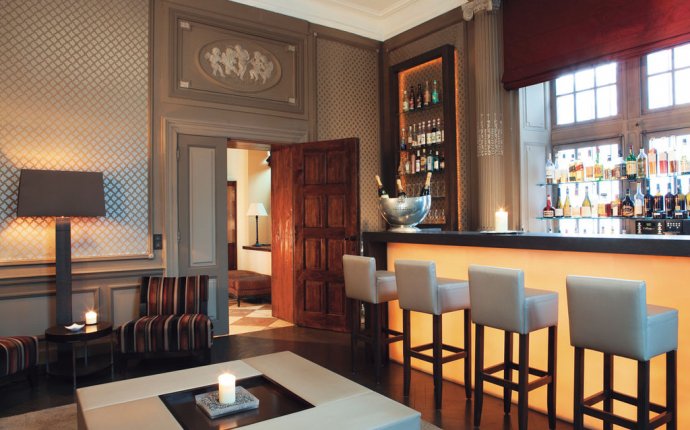
Restaurants Spa Belgium
The word spa, named after the Belgian resort city of Spa, once tripped on the lips of only the privileged few willing to pay the price of lolling in mud baths, sipping natural spring water and nibbling on gastronomie dietetique in order to thin down in luxurious settings.
Today, however, more and more restaurants and hotels coast to coast are serving spa food, meaning food that is not only healthful but light and lovely, too.
In New York, such haute restaurants as Four Seasons, which claims credit for and had copyrighted the coined phrase "spa cuisine" in 1983, along with less costly eateries such as Trumpet's Restaurant at the Grand Hyatt, are featuring special "fitness" or "spa" menus with the emphasis on healthful as well as beautiful food.
On the West Coast, several major hotel restaurants, generally known as bastions of hearty, continental cuisine, have gone spa, among them the Polo Lounge at the Beverly Hills Hotel, the Garden Pavilion at the Century Plaza Hotel and the cafe restaurants at the Ritz-Carlton Laguna Niguel.
Chef Raimund Hofmeister of the Century Plaza Hotel uses an American Heart Assn.-approved menu designed to provide about 55% carbohydrates, 15% protein and 30% fat for each balanced meal. "Most people who eat in restaurants have one meal a day and we want to be sure it's properly balanced in every way, " Hofmeister said.
A few restaurant operations, such as Geoffrey's in Malibu, Carbo's in Newport Beach and 400 North Canon in Beverly Hills, have built their restaurants around the concept of spa food-beautiful food that is also healthful for you.
Definitions of spa food, we discovered, however, differ from restaurant to restaurant.
Some may perceive spa food as dietetic, meant to help the dieter thin down. This notion has lost favor over the idea of spa food as being simply healthful food that is low in calories, fat, cholesterol, salt and sugar, as well as beautiful in appearance and small in portion size.
Others regard the use of fresh ingredients as a measure of spa food.
Still others see the cuisine as a style. One may cheat on calories and use fat and sugar in regular amounts, as long as the food appears low-caloried and aesthetically pleasing.
And to prove it, we have examples of such definitions here.
At the Beverly Hills Hotel Polo Lounge the emphasis is on fitness even though the dishes are presented attractively enough to give pause. The dishes are "prepared with reduced fat, cholesterol and no addition of salt during the cooking process, " states the menu. The offerings are rather simple, geared to the tastes of clients accustomed to uncomplicated but good food.
On the fitness menu there are garden crudites served with low-fat yogurt dressing, a watercress and cucumber sandwich, a vegetable club sandwich made with tomatoes, cucumber, avocado, Japanese mushrooms, alfalfa sprouts, mache and seven-grain bread spread with yogurt. Instead of whole milk, the menu suggests skim milk, low-fat milk or buttermilk, which contain almost half the calories of regular milk. The sandwiches on the fitness menu are particularly appealing, and a recipe for their vegetable club sandwich is found here.
At Neiman-Marcus, a national specialty department store chain, the interpretation of " haute cuisine without haute calories" is somewhat loose. Calling its menu "Lights, " it features well-designed dishes that appear light in texture and taste.
"To us, 'Lights' means beautiful food with a light look, " said Dale Shumate, director of public relations at Neiman-Marcus. The dishes may or may not be low in calories, although they always appear to be. A crab-grapefruit salad, for instance, composed of crab meat with grapefruit, avocado and papaya and a yogurt sauce contains 427 calories. A crab-stuffed avocado with a tomato and olive-cilantro sauce contains a low 277 calories, whereas an olive-crab calzone has 776 calories per serving. A recent promotion of the "Lights" menu featured Alaskan crab, California olives and Mirrasou Pastel wine ice and cocktail.
The spa food menu of 400 North Canon, a small cafe in Beverly Hills, was designed by owners Mark Warwick and Kim Hoffman with the help of the chef, Nicholas Klontz, a native of Spa, Belgium.
"I have been working on this cuisine for years because I believe it is the cuisine of the future, " said Klontz, whose peach mousse, pictured on Page 1, may look rich, but actually contains fewer calories than expected. Klontz's recipes use fruit juices, cider, wine, vegetable and fish stock, low-fat cheeses and yogurt in place of rich meat stocks and sauces made with butter. The peach mousse is made with yogurt and peach puree using simple syrup to sweeten the dessert, although artificial sweetener may be used as well. Presentation is all-important.









